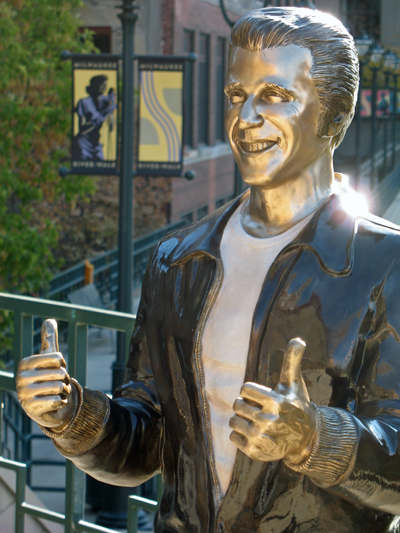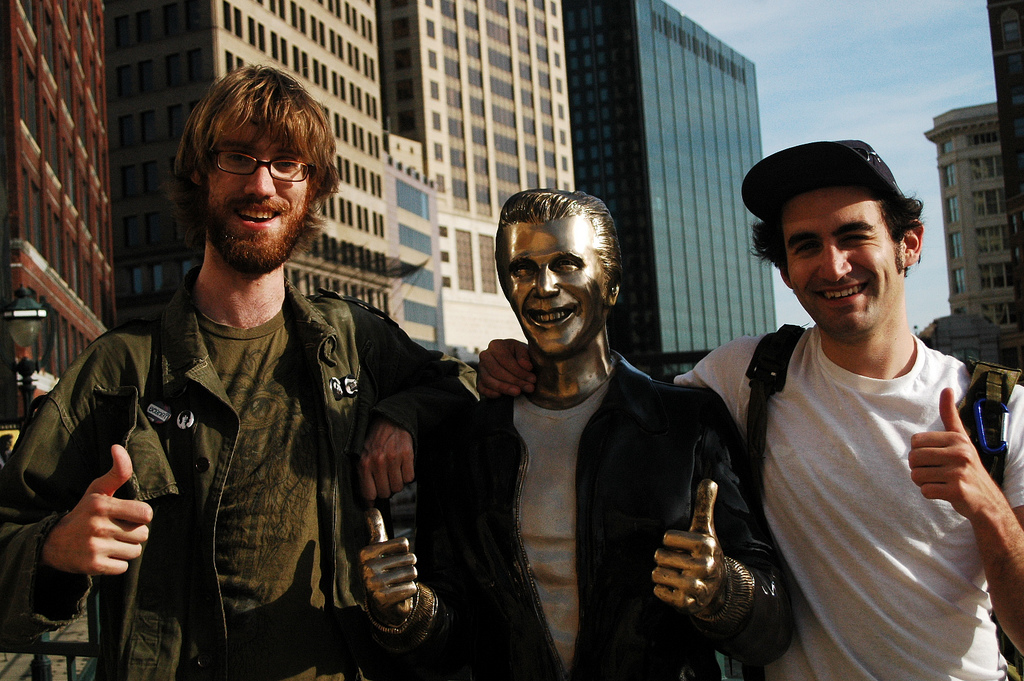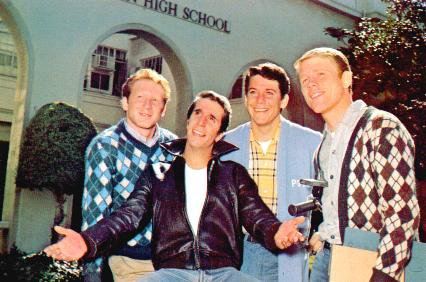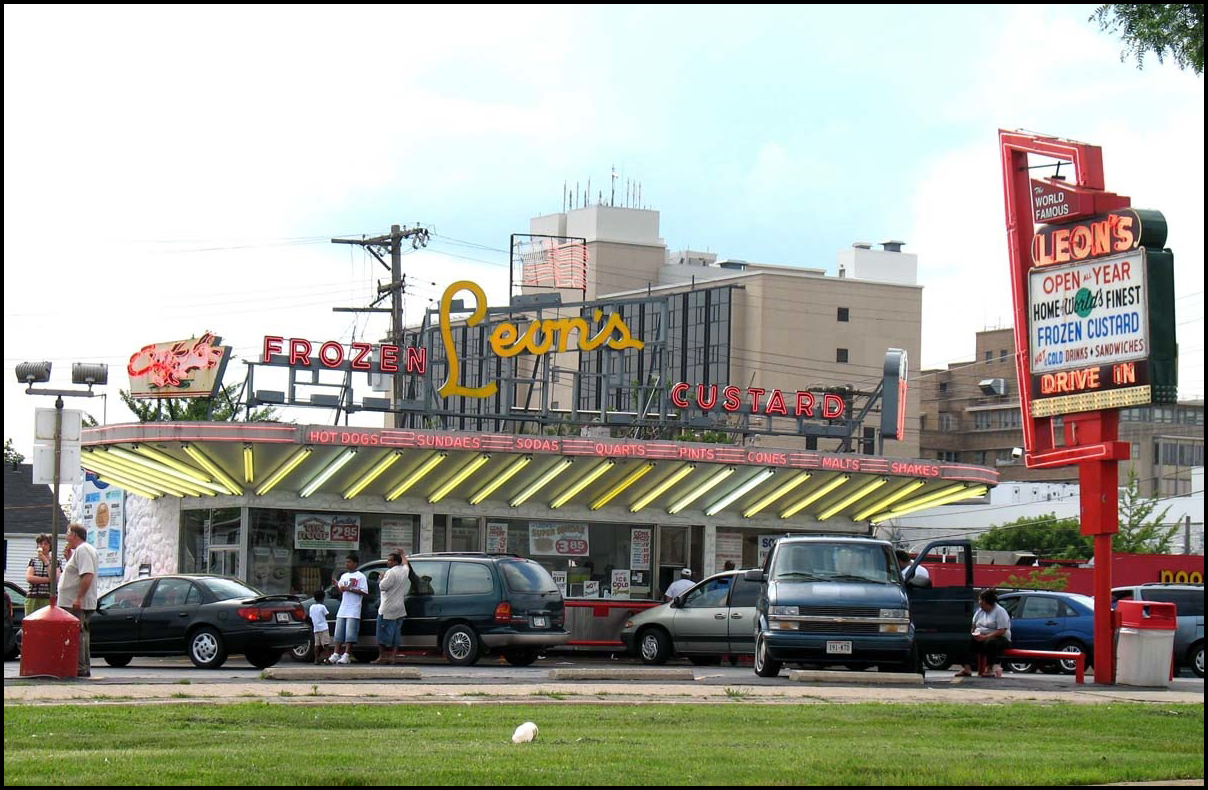The Bronze Fonz: Public Art/Popular Culture in Milwaukee, Wisconsin
Michael Z. Newman / University of Wisonsin-Milwaukee

The Bronze Fonz
In August the latest in a series of recent public artworks in the U.S. honoring TV and movie characters was installed in downtown Milwaukee, Wisconsin: a life-size bronze statue of Arthur Fonzarelli– Fonzie, The Fonz–with his signature two thumbs up. Other statues, most sponsored by TV Land, have included Rocky Balboa at the Philadelphia Museum of Art, Ralph Kramden at the Port Authority Bust Terminal in New York City, and Mary Richards tossing her tam skyward in Minneapolis.
The Fonz of course was a main character in the ABC sitcom Happy Days whose black motorcycle jacket was long ago enshrined at the Smithsonian alongside Archie and Edith Bunker’s chairs. Although shot in Los Angeles in the 1970s, Happy Days was set in Milwaukee in the 1950s, as was its spinoff Laverne & Shirley. Henry Winkler, who played Fonzie, and much of the rest of the Happy Days cast “returned” to Milwaukee for an unveiling. A crowd showed up. Speeches were made. Photos were snapped. Now the statue is a point on the city’s tourist itinerary, along with brewery tours and museums and the pretty lakeshore.
[youtube]http://www.youtube.com/watch?v=mWo0WE7cPjU&feature=related[/youtube]
The announcement in 2007 of plans for the Bronze Fonz was the occasion for more than just curiosity and excitement. Within the city’s arts community, the Bronze Fonz was an object of controversy and scorn. Rather than a project spurred by local arts institutions, the Bronze Fonz was the product of funds raised by Visit Milwaukee, a non-profit agency whose mandate is to promote tourism to boost the local economy. The Bronze Fonz was launched without the sanction of anyone in the local art world, and the local art world bristled at this trespass onto its turf. A prominent gallery owner threatened to close up shop and leave town if the plans went ahead (his gallery did close earlier this year). The director of the Milwaukee Art Museum wrote in opposition to the Bronze Fonz. The Milwaukee Journal-Sentinel art critic followed the controversy in a series of blog posts gently slanted against the project. A debate was joined between defenders of a concept of public art as serious and important to a city’s legitimate cultural identity on one side, and defenders of the virtues of increased tourism and fun on the other. The aesthetic mission of art opposed the crowd-pleasing, commercial taint of entertainment, and entertainment won the day.
This episode was yet another occasion for reasserting the cultural hierarchies which place television and pop culture as illegitimate, and which function to reproduce social distinctions. Even the statue’s promoters bought this line. The CEO of Visit Milwaukee, Dave Fantle, told a Journal-Sentinel reporter that the Bronze Fonz is “not art but a piece of pop culture.” In part this clarification was self-justifying; Visit Milwaukee managed an end around the usual processes involved in installing a public artwork in a prominent city location. But no matter the motivation, the discourse positioning a Fonzie statue as at best frivolous fun misses the appeal and significance of popular culture in ordinary people’s lives. To look at the photos people take of themselves posing with the statue is to recognize the depth of our identification with the narratives of popular culture. It might be fun, but it isn’t frivolous.

Sam and Mike with the Bronze Fonz
But at stake in this debate was more than just the promotion of values endorsed by the snooty guardians of culture or the populist civic boosters. The identity of the city was also a term in the controversy, and this identity is tied up in the representation of place in popular culture like Happy Days and Laverne & Shirley.
Like many Midwestern cities, Milwaukee’s past as a site of productive industry is more glorious than its post-industrial present. Today unemployment is high, especially among the city’s large and segregated racial underclass, and economic growth is slow. The city does not like to present this face to the region, the country and the world. It hopes to attract “creative class” young people and spendthrift convention tourism. It wants to seem like a hip, vibrant town with plenty of attractions to excite out-of-towners.
Happy Days (and Laverne & Shirley) might be a fond memory, but is not much to hang onto as a point of pride for Milwaukee. The setting was in some ways incidental to the show. Its producer Garry Marshall wanted to set Happy Days in his hometown of the Bronx, but the folks at Paramount thought this would come off as too ethnic (Brant, 20). They were looking to duplicate the family format of 1950s shows like Father Knows Best and clearly preferred to represent an idealized middle America. Wisconsinites are proud of their culture, for instance their foodways (the German-influenced beer and sausages; dairy foods like cheese and frozen custard; and Friday fish fry events where the Brandy Old Fashioneds are more often savored than the fish). But the ethnic or regional identity of Wisconsin or Milwaukee is hardly in evidence in Happy Days. For instance, more of the show’s characters have Italian names (Fonzarelli, Delvecchio) than the more locally common German ones. One hears more New York accents like Winkler’s than Wisconsin accents. You wouldn’t know from watching Happy Days that the typical white Milwaukeean speaks more like Sarah Palin than Mrs. C.
The setting of the show in Milwaukee was in a sense the denial of place rather than an investment in it. Marshall, and Italian-American and New Yorker, seems to have wanted to do urban-ethnic, but in some ways the specificity of his characters’ identities got scrubbed from the representation. Setting the show in Milwaukee was a way of striking a note of Americana — an idealization of “normal” America just as much as it was an idealization of the 1950s as a more innocent and familiar and comforting time in history. Jefferson High, where the characters go to school, and Arnold’s drive-in restaurant, where they slurp milkshakes and dance to jukebox records, are meant to be the kind of school and hangout that you might find anywhere in the USA.

Fonz with the cast of Happy Days
Milwaukee can be tickled to have a Fonzie statue because Fonzie is essentially cool. But it’s hard to be proud to have been chosen as an undistinct enough place to stand in for Anytown, USA. America of the big cities and coasts is often blind to the specificity of the places in the middle of the country, and Happy Days is symptomatic of this. (Things change in Laverne & Shirley, which is more blue-collar and which has the brewery setting to add local color.)
But we are also proud to have been the setting of a popular show at all, an opportunity for “Milwaukee” to have been uttered on a regular basis to an audience of millions. To this day, legend persists that a frozen custard stand called Leon’s was the inspiration for Arnold’s. Leon’s has gorgeous vintage signage and looks like it hasn’t changed since the 1950s.

Leon’s Frozen Custard Stand
If you ask the custard server if it’s true about Leon’s being the original Arnold’s she might say yes (I’ve heard it myself). But the truth is otherwise. Tom Miller, a producer at Paramount, suggested setting Happy Days in the suburban Milwaukee neighborhood where he grew up after Garry Marshall’s Bronx setting was nixed (Brant, 20). Jefferson High was based on Nicolet High in Glendale, WI. Arnold’s was based on a drive-in called The Milky Way on Port Washington Rd. that no longer exists. But it pleases people around town to think that the place that inspired Arnold’s still serves food, and that you can still go back there if you want to visit the 1950s as represented on television. Like everywhere else, nostalgia for a past that never existed lives in Milwaukee.
Image credits:
1. The Bronz Fonz – photo by author
2. Sam and Mike with the Bronze Fonz – used with permission
3. Fonz with the cast of Happy Days – Author’s personal collection
4. Leon’s Frozen Custard Stand – photo by author
Please feel free to comment.
Thanks for this thoughtful, beautifully written piece. I really like the way you draw attention to the role of tv-based public (though often privately sponsored) art, to tv nostalgia and to the slipperiness of ethnic representations in popular culture. Miriam Greenberg’s new book on urban branding is certainly relevant to this discussion.
Yes, I agree. This is an interesting thing to think about. I myself grew up in a region that has been made iconographic through the writings of Larry McMurtry — Texasville was shot in my home town — and there’s an interesting overlap in the way that the specificity of something like McMurtry’s work can work to the same ends as the placelessness of something like Happy Days. In both, there’s a sort of flattening of the real and a crystallization of time, and the past that was can function much like the past that never was.
And, of course, the debate over the purpose and role of public art is always contentious. I think the question I always turn to is which public is the art supposed to serve? The general public, who seems pleased with the statue? Or, the art public, who finds it revolting? I think too often “public art” means art provided to the public, rather than for or with the public.
In short, a fascinating piece that could be the jumping off point for a number of discussions.
Although the Rocky statue in Philadelphia was not actually related to any of the other statues, it too has a fascinating and pertinent history. It was constructed by Sylvester Stallone for use in Rocky III after which he “donated” it to the City of Philadelphia and the Philadelphia Museum of Art… they however didn’t want it for the exact reasons you cited about the Fonz statue in Milwaukee: the art world said it was a movie prop not art. It was subsequently placed at the Spectrum arena in South Philadelphia (where the fights in Rocky I and II took place) and moved back to the art museum briefly for filming other movies (including subsequent Rocky movies and also the movie Philadelphia). What is particularly interesting is the way in which after 25 years the Philadelphia art community allowed the statue to be re-erected at the art museum (though at the bottome of the stairs, not the top as in the movies) because of the immense interconnection between the city and Rocky both in cultural history and in public history and in the minds of the people of Philadelphia.
My point with this extended recounting of the Rocky statue in Philadelphia is that it is very intersting to see the ways in which different cities adopt and adapt their cultural representations in media over time. Of course with or without a statue the iconic steps are bounded up with tourists (and locals) humming “gonna fly now” daily
What is further interesting in the case of Philadelphia is that it is has a history of public art from the Calders to Robert Indiana’s Love statue to the Percent for Art program started in 1959 mandating one percent of all new building projects be devoted to public art. Where has Rocky fit into this tradition of art and public art which has ranged from 37 foot realist William Penn statue atop City Hall to Alexander Calder’s abstract “stabiles” to the pop art of Robert Indiana? In this range of artwork and definitions of art, why did it take so long to accept a pop cultural icon (and Academy Award winner) to be accepted as art?
In any case, great article and a debate about media and place which I would love to see explored further.
Great work. I really enjoyed this essay and fully intend to get my own picture next to the Bronze Fonz next time I’m in Milwaukee.
I recently did some work on how Wisconsin is represented on television, although more specifically through the show “Aliens in America” – and in doing so realized that the list of Wisconsin-set shows is surprisingly lengthy. But that was one of my favorite aspects of the Bronze Fonz debates, that in one article I read someone argued that the Fonz was at least cooler than Shirley Feeney and Laverne DeFazio. So the issue is for some not only about high culture/low culture divides, but rather that Milwaukee has such an excess of television history that they can choose which TV icon to have bronzed.
I think it’s interesting to consider that this statue is not only being tied to the show’s fictionalized 1950s, but perhaps also to the 1970s Milwaukee that saw “Happy Days” in its initial run – there are multiple eras in play to be nostalgic for, and the statue could just as easily evoke personal memories of where and when someone watched the show in addition to recalling the narrative setting. Those kinds of personal ties are real even if the show’s semi-generic version of Milwaukee is decidedly less so.
Nice piece, Mike, especially about Milwaukee as a stand-in for Anywhere, USA and thus leeching any meaning from its potential specificity. I eagerly await the statue of four teenagers sitting in around a table in a smoke-filled basement as a tribute the That ’70s Show, which did play up the Wisconsin setting a little bit more. Perhaps the whole thing could periodically swivel 90 degrees.
The 50’s were my parents generation, and the Fonz is accurately portrayed as a real person in Milwaukee. I really believe that the Bronze Fonz really represents the city of Milwaukee very well. It immortalized the values he portrayed on the t.v. series “Happy Days”. Although jobs are hard to find now compared to the 1950’s, the Bronze Fonz makes a positive thing for people to view when they come to Milwaukee. I’m glad the producers of “Happy Days” chose Milwaukee as the home of the Fonz. The Bronze Fonz represents a more peaceful, fun loving 1950’s as compared to the hectic lifestyles of today.
That’s… really… kinda creepy, lol.